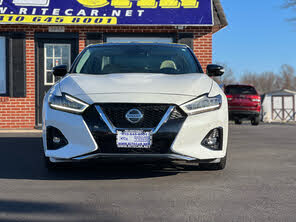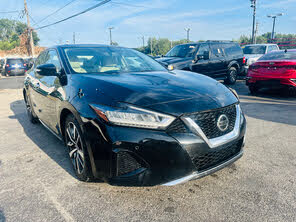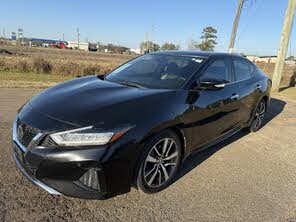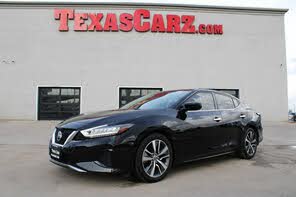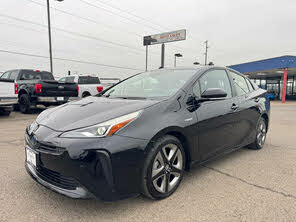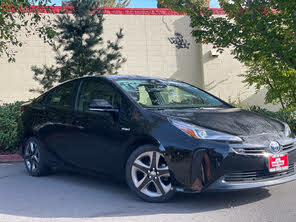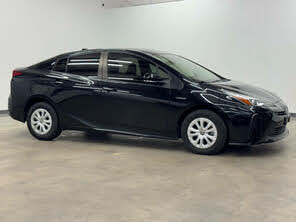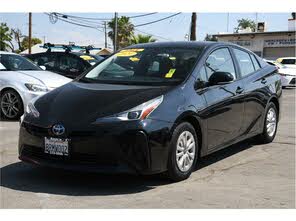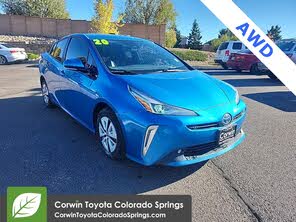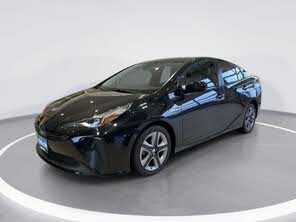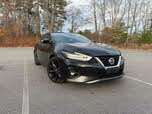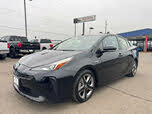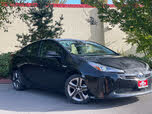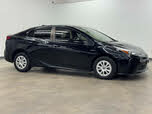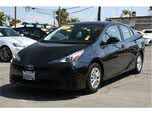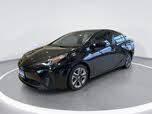2019 Nissan Maxima vs 2020 Toyota Prius
Overview | |
MSRP$34,050 | MSRP$24,325 |
Average price$19,997 | Average price$22,146 |
Listings185 | Listings230 |
Ratings & Reviews | |
User Reviews | User Reviews |
Expert reviews7.5 out of 10 | Expert reviews7.5 out of 10 |
Pros
| Pros
|
2019 Nissan Maxima Reviews SummaryThe Maxima has endured for eight generations as a premium midsize Nissan sedan. While not the “four-door sports car” that Nissan proclaims, the Maxima’s powerful V6 engines and crisp handling have earned it a solid reputation over the past three decades. We last tested the Maxima when this generation was brand-new for 2016. Now that Nissan has refreshed it ever so mildly for 2019, we’ve taken another look at its updated style, technology, and interior features. | |
2020 Toyota Prius Reviews SummaryEver heard of an eponym? It’s a brand or product that is so popular that it’s come to define its respective market. Think of Kleenex for tissues or Band-Aid for medical bandages. For hybrids, the Toyota Prius has ascended to near-eponym status. It was one of the first—and remains one of the most popular—hybrids ever made. As automakers across the industry are rolling out more hybrid models, the Prius continues to be the standard-bearer of this genre. This is largely due to the fact that the Prius is a dedicated hybrid, rather than a hybrid variant of an existing model. Throughout the industry, different companies are taking different approaches to alt-fuel vehicles, including full-electric and hydrogen fuel cell powertrains. The Prius endures as the leader in hybrid power due to a focus on fuel efficiency that doesn’t compromise on style, drivability, and versatility. So how does the Prius hold its ground as more players enter the fray? Read on to find out. | |
No video found | |
Popular Features & Specs | |
Engine3.5L 300 hp V6 | Engine1.8L 121 hp I4 Hybrid |
Drive TrainFWD | Drive TrainFWD |
Seating Capacity5 | Seating Capacity5 |
Horsepower300 hp @ 6400 rpm | Horsepower |
EV Battery Capacity | EV Battery Capacity0.7 kWh |
MPG City20 | MPG City58 |
MPG Highway30 | MPG Highway53 |
Engine | |
Engine Name3.5L 300 hp V6 | Engine Name1.8L 121 hp I4 Hybrid |
Torque261 lb-ft @ 4400 rpm | Torque |
Horsepower300 hp @ 6400 rpm | Horsepower |
DrivetrainFWD | DrivetrainFWD |
Fuel Economy | |
EV Battery Capacity | EV Battery Capacity0.7 kWh |
MPG City20 | MPG City58 |
MPG Highway30 | MPG Highway53 |
Interior | |
Seating Capacity5 | Seating Capacity5 |
Key Features | |
Navigation SystemStandard | Navigation System |
Safety | |
Front Crash Overall | Front Crash Overall4 |
Side Crash Overall | Side Crash Overall5 |
Dimensions & Capacity | |
Cargo Space14.3 cu ft | Cargo Space27.4 cu ft |
Curb Weight3552 lbs | Curb Weight3010 lbs |
Height56.5 in | Height57.9 in |
Length192.8 in | Length180.0 in |
Width73.2 in | Width69.3 in |
Wheelbase109.3 in | Wheelbase106.3 in |
Maximum Payload1133 lbs | Maximum Payload825 lbs |
Number of doors4 | Number of doors4 |
Overview | ||
MSRP | $34,050 | $24,325 |
Average price | $19,997 | $22,146 |
Listings | ||
Ratings & Reviews | ||
User reviews | ||
Expert reviews | 7.5 out of 10Read full review | 7.5 out of 10Read full review |
Pros & cons | Pros
| Pros
|
Summary | The Maxima has endured for eight generations as a premium midsize Nissan sedan. While not the “four-door sports car” that Nissan proclaims, the Maxima’s powerful V6 engines and crisp handling have earned it a solid reputation over the past three decades. We last tested the Maxima when this generation was brand-new for 2016. Now that Nissan has refreshed it ever so mildly for 2019, we’ve taken another look at its updated style, technology, and interior features. | Ever heard of an eponym? It’s a brand or product that is so popular that it’s come to define its respective market. Think of Kleenex for tissues or Band-Aid for medical bandages. For hybrids, the Toyota Prius has ascended to near-eponym status. It was one of the first—and remains one of the most popular—hybrids ever made. As automakers across the industry are rolling out more hybrid models, the Prius continues to be the standard-bearer of this genre. This is largely due to the fact that the Prius is a dedicated hybrid, rather than a hybrid variant of an existing model. Throughout the industry, different companies are taking different approaches to alt-fuel vehicles, including full-electric and hydrogen fuel cell powertrains. The Prius endures as the leader in hybrid power due to a focus on fuel efficiency that doesn’t compromise on style, drivability, and versatility. So how does the Prius hold its ground as more players enter the fray? Read on to find out. |
Video | No video found | |
Popular Features & Specs | ||
Engine | 3.5L 300 hp V6 | 1.8L 121 hp I4 Hybrid |
Drive Train | FWD | FWD |
Seating Capacity | 5 | 5 |
Horsepower | 300 hp @ 6400 rpm | |
EV Battery Capacity | 0.7 kWh | |
MPG City | 20 | 58 |
MPG Highway | 30 | 53 |
Engine | ||
Engine Name | 3.5L 300 hp V6 | 1.8L 121 hp I4 Hybrid |
Torque | 261 lb-ft @ 4400 rpm | |
Horsepower | 300 hp @ 6400 rpm | |
Drivetrain | FWD | FWD |
Fuel Economy | ||
EV Battery Capacity | 0.7 kWh | |
MPG City | 20 | 58 |
MPG Highway | 30 | 53 |
Interior | ||
Seating Capacity | 5 | 5 |
Key Features | ||
Navigation System | Standard | |
Safety | ||
Front Crash Overall | 4 | |
Side Crash Overall | 5 | |
Dimensions & Capacity | ||
Cargo Space | 14.3 cu ft | 27.4 cu ft |
Curb Weight | 3552 lbs | 3010 lbs |
Height | 56.5 in | 57.9 in |
Length | 192.8 in | 180.0 in |
Width | 73.2 in | 69.3 in |
Wheelbase | 109.3 in | 106.3 in |
Maximum Payload | 1133 lbs | 825 lbs |
Number of doors | 4 | 4 |
The 2019 Nissan Maxima showcased a refined version of Nissan’s V-shaped design, which had become more acceptable over the years. For 2019, the Maxima received new projector-beam LED headlights with intricate reflector patterns, an edgier grille, and a silver bumper strip beneath enlarged fog-lamp enclosures. The LED taillights were tinted black and featured similar reflector patterns for the turn signals, sitting above a revised bumper and quad tailpipes. Despite these updates, the Maxima retained its concave front fascia, wavy side creases, and the distinctive “floating roof” design. Inside, all Maxima models received upgraded, softer materials. The SV trim, which was tested, featured contrast stitching on the dash, tight panel gaps, polished black console trim, and minimal use of hard plastic. The all-black interior of the Maxima SV highlighted its quality with ample padding and upscale textures, making it a rewarding experience for drivers.
The 2020 Toyota Prius maintained its iconic jellybean-like shape, optimized for aerodynamic efficiency. This shape had been a staple since the second generation, with Toyota making subtle changes to styling cues over the years. The current generation featured visual tricks to give it a more sedan-like appearance, though it remained a hatchback. The Prius had a futuristic style, and its cabin was revolutionary with a central location for instrumentation and gauges. The Prius offered four trim levels: L Eco, LE, XLE, and Limited. The L Eco trim came with 15-inch alloy wheels, automatic climate control, cloth upholstery, push-button start, three USB ports, Bluetooth connectivity, and a 7-inch touchscreen infotainment system with Apple CarPlay, Android Auto, and Amazon Alexa compatibility. Higher trims added features like synthetic leather upholstery, heated seats, and a larger 11.6-inch touchscreen.
The 2019 Nissan Maxima was powered by a 3.5-liter V6 engine producing 300 horsepower and 261 pound-feet of torque, paired with a continuously variable transmission (CVT) that sent power to the front wheels. Despite being a powerful front-wheel-drive car, the Maxima managed to mitigate torque steer effectively. The traction control system was well-tuned, providing smooth and immediate thrust without the engine straining at high revs. The Maxima’s CVT simulated gear ratios well, and the V6 engine was both strong and sonorous. However, the Maxima’s driving experience was marred by a mushy brake pedal and numb, over-boosted steering. The suspension was tuned to offer a near-perfect balance of ride quality and nimble response, making the Maxima fun to drive despite its steering and brake shortcomings. The Maxima achieved an EPA-estimated fuel economy of 20 mpg city, 30 highway, and 24 combined.
The 2020 Toyota Prius featured a 1.8-liter four-cylinder engine paired with an electric motor and battery, producing a combined 121 horsepower and 105 pound-feet of torque. The Prius was available in both front-wheel drive (FWD) and all-wheel drive (AWD) variants, with the AWD-e model employing a second electric motor for the rear wheels. The Prius offered smooth and confident acceleration, especially at lower speeds, with a seamless transition between electric and conventional power. It had three drive modes: EV, Eco, and Power. The unique shifter design required some getting used to, with Reverse, Drive, Neutral, and Park positions arranged differently than in conventional cars. The Prius also featured an Engine Braking mode for better control on downhill slopes. The Prius handled well for a hybrid, with a low center of gravity providing sharper handling than expected. The ride was smooth, making it ideal for commuting.
The 2019 Nissan Maxima featured a single 8-inch display integrated into the dash, which could be operated by touch or knob. The display was quick to respond, and shortcut buttons for various functions flanked the sides of the touchscreen. The Maxima’s thick pillars and slim D-pillar slightly compromised sightlines, and the trunk offered 14.3 cubic feet of space, which was smaller than some competitors. However, the Maxima provided ample passenger room in both the front and rear seats. The front seats were particularly comfortable, designed to reduce muscle fatigue with Zero Gravity technology. The seating position was driver-oriented, with a flat-bottom steering wheel and a canted center stack.
The 2020 Toyota Prius made excellent use of its compact platform, offering deep door pockets, a large tray area between the front seats, and helpful sub-trays around the center console. The front seats were spacious and comfortable, with plenty of headroom and legroom. Driver visibility was good, and the rear seats also provided ample space, though taller passengers needed to watch their heads when getting in and out. The Prius offered 50.7 cubic feet of cargo space with the rear seats folded, and 24.6 to 27.4 cubic feet with the seats up, depending on the model. This made the Prius one of the most spacious and versatile hybrid vehicles available, with its hatchback design facilitating easy loading of large items.
The 2019 Nissan Maxima came with an updated navigation system on all trims except the base S. The system occasionally lagged but was more detailed and clearer than before. The infotainment home screen could be customized, and another screen displayed SiriusXM data. Apple CarPlay and Android Auto were standard, along with a high-speed USB-C port. The Maxima was compatible with Amazon Alexa and Google Assistant, offering remote services like automatic 911 dialing, stolen-vehicle tracking, and geofencing alerts. The instrument panel screen could display multiple readouts simultaneously. The Bose stereo system featured active noise cancellation, but the Maxima lacked Nissan’s ProPilot Assist suite of semi-automated driving functions.
The 2020 Toyota Prius came standard with a 7-inch touchscreen, featuring a sensible menu layout and standard Android Auto and Apple CarPlay. Other standard features included Bluetooth connectivity, a WiFi hotspot, and three USB ports. The Limited trim upgraded to an 11.6-inch screen with a customizable, tablet-like layout. This screen came with Apple CarPlay but lacked Android Auto. The Prius was available with satellite radio, HD Radio, a head-up display (HUD), and a 10-speaker JBL premium audio system. The top-center instrument panel displayed hybrid drivetrain status and other critical readouts, with menus toggled via the steering wheel. The available HUD provided additional convenience.
The 2019 Nissan Maxima came with standard safety features like forward-emergency braking and a driver-attention monitor. Knee airbags for both the driver and front passenger were also standard. The SV trim added blind-spot monitoring and adaptive cruise control, while the SR trim included pedestrian detection and lane-departure warning. Platinum models featured reverse emergency braking. The Maxima received a 5-star overall rating from the NHTSA and was an IIHS Top Safety Pick, scoring well in all crash tests and for its emergency braking system.
The 2020 Toyota Prius was equipped with Toyota Safety Sense 2.0, which included automatic emergency braking, forward-collision warning, lane-departure warning, adaptive cruise control, and automatic high beams. Optional safety features included blind-spot monitoring, rear cross-traffic alert, front-and-rear parking sensors, and active park assist. The Prius earned a five-star rating from the NHTSA and a "Top Safety Pick" accolade from the IIHS, though it fell short of the highest rating due to "average" scores in certain crash tests and headlight performance.
CarGurus highlights

According to CarGurus experts, the overall rating for the 2019 Nissan Maxima is 7.5 out of 10, while the 2020 Toyota Prius scores 7.5 out of 10. Given these equal ratings, the final recommendation depends on your priorities. If you seek a powerful and stylish sedan with a luxurious interior, the 2019 Nissan Maxima is a great choice. However, if you prioritize fuel efficiency, versatility, and advanced safety features, the 2020 Toyota Prius is the better option.
Choose the 2019 Nissan Maxima if:
- You prefer a powerful V6 engine with smooth and immediate acceleration.
- You value a refined and upscale interior with high-quality materials.
- You want a sedan with a well-balanced suspension for a comfortable yet nimble ride.
Choose the 2020 Toyota Prius if:
- You prioritize fuel efficiency and seamless hybrid performance.
- You need a spacious and versatile vehicle with ample cargo space.
- You want a car with a comprehensive suite of standard safety features.
CarGurus highlights

According to CarGurus experts, the overall rating for the 2019 Nissan Maxima is 7.5 out of 10, while the 2020 Toyota Prius scores 7.5 out of 10. Given these equal ratings, the final recommendation depends on your priorities. If you seek a powerful and stylish sedan with a luxurious interior, the 2019 Nissan Maxima is a great choice. However, if you prioritize fuel efficiency, versatility, and advanced safety features, the 2020 Toyota Prius is the better option.
Choose the 2019 Nissan Maxima if:
Shop Now- You prefer a powerful V6 engine with smooth and immediate acceleration.
- You value a refined and upscale interior with high-quality materials.
- You want a sedan with a well-balanced suspension for a comfortable yet nimble ride.
Choose the 2020 Toyota Prius if:
Shop Now- You prioritize fuel efficiency and seamless hybrid performance.
- You need a spacious and versatile vehicle with ample cargo space.
- You want a car with a comprehensive suite of standard safety features.

By: CarGurus + AI
At CarGurus, our team of experienced automotive writers remain at the heart of our content operation, conducting hands-on car tests and writing insightful guides that are backed by years of industry experience. To complement this, we are harnessing AI to make our content offering more diverse and more helpful to shoppers than ever. To achieve this, our AI systems are based exclusively on CarGurus content, ratings and data, so that what we produce is both unique to CarGurus, and uniquely helpful to car shoppers.






















